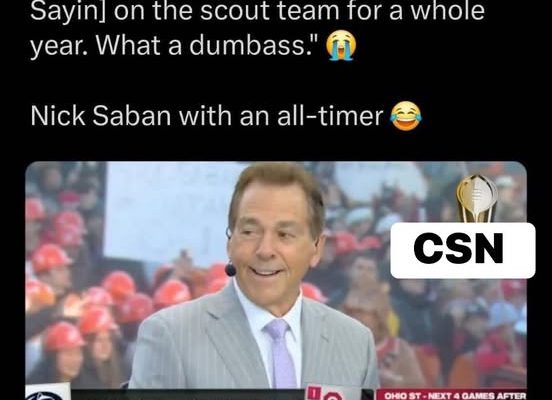When news broke that quarterback Julian Sayin had decided to transfer from Alabama, it sent ripples through the college football world—and it didn’t take long for fans and insiders alike to wonder what Nick Saban thought about it. Sayin, one of the most hyped quarterback recruits in the nation, was considered the future face of the Crimson Tide offense. His departure not only marked a shift in the quarterback room but also stirred up reflections on Saban’s long and storied approach to managing elite talent. Though Saban’s response was measured and characteristically professional, those close to him know it carried the weight of both disappointment and understanding—a reflection of a coach who has seen nearly everything in the modern era of college football.
Saban’s initial reaction, according to those within the Alabama program, was one of calm acknowledgment rather than shock. After nearly two decades at the helm, Saban understood better than anyone that the landscape of college football had changed dramatically. The transfer portal, NIL opportunities, and the growing sense of player autonomy had transformed how rosters evolved. What might have once been a stunning betrayal now felt like a reflection of the times. Still, Saban’s respect for Sayin as a player and person made the departure sting more than usual. Sayin was, after all, one of the most polished quarterback prospects Alabama had signed in years—a cerebral, accurate passer with the poise and leadership traits that once defined Tide greats like Mac Jones and Bryce Young.
Privately, Saban was said to have expressed disappointment—not in Sayin’s decision, but in the broader system that allowed such departures to become so common. The coach had long been vocal about the impact of the transfer portal and NIL deals on player development, often noting that young athletes were being pressured to make long-term decisions based on short-term frustrations or financial promises. Saban believed in process—a word that became synonymous with his coaching philosophy. He taught players to buy into hard work, delayed gratification, and steady improvement. Sayin’s decision to leave before truly competing for the starting role was, in Saban’s eyes, a reminder of how difficult it had become to convince young stars to trust the process in a sport increasingly driven by instant results.
However, what separated Saban from many of his peers was his ability to balance old-school discipline with empathy. Those who spoke with him after Sayin’s transfer said he didn’t resort to criticism or resentment. Instead, he acknowledged that every player’s path is unique. He had always said that college football should be about helping young men grow, not just producing NFL draft picks. Sayin, in his view, had to make the decision he felt was best for his future—even if that future didn’t align with Alabama’s plans. It was the same perspective Saban had taken in previous high-profile departures, from quarterbacks like Jalen Hurts to defensive standouts who sought new beginnings elsewhere.
Publicly, Saban’s comments were characteristically measured. He expressed gratitude for Sayin’s time at Alabama, praised his talent, and wished him success wherever he went. Beneath that calm exterior, however, was an unmistakable sense of reflection. The coach who had built one of the most disciplined dynasties in sports was once again facing the consequences of a system he had little control over. It wasn’t about losing one player—it was about the broader challenge of maintaining continuity in a sport increasingly defined by volatility.
Sayin’s departure also reignited conversation about Alabama’s quarterback situation, both during and after Saban’s era. During his tenure, Saban had managed quarterback transitions with surgical precision. From A.J. McCarron to Tua Tagovailoa to Bryce Young, each era felt like a carefully crafted handoff. Yet in the twilight of his career, the constant movement of players—through the portal, through early NFL declarations—made that continuity harder to preserve. Sayin had been expected to be part of the next great transition, perhaps even the cornerstone of Alabama’s offense for years to come. His transfer disrupted that vision and symbolized the new era Saban had long warned about: one where building a program was less about culture and more about constant roster management.
Insiders close to the program say Saban took Sayin’s departure as an opportunity to remind his staff of the importance of adaptability. He often spoke about the need to evolve with the game, and even in moments of frustration, he maintained a forward-thinking approach. Rather than dwell on who had left, he focused on who remained and what could still be built. That mindset—rooted in control, discipline, and forward motion—was what made Saban’s Alabama reign so legendary. Sayin’s exit may have been a setback, but it wasn’t a crisis. Under Saban, there was never time for panic, only preparation.
For Sayin himself, Saban’s reaction carried weight. The young quarterback had spoken glowingly about the coach who recruited him—praising Saban’s honesty, attention to detail, and ability to bring out the best in his players. Even in leaving, Sayin was said to have handled things respectfully, a testament to the mutual respect between the two. Saban, in turn, made sure the door remained open. He had always believed that burning bridges benefited no one, and in an era where players often transferred multiple times, maintaining good relationships mattered.
What Sayin’s transfer underscored most was the duality of Saban’s legacy. On one hand, he was the ultimate symbol of stability and structure—the architect of a system that demanded commitment, accountability, and patience. On the other hand, he had coached through the most volatile era in college football history, adapting to NIL, the transfer portal, and the growing professionalization of college athletics. Each change had tested his philosophy, forcing him to reconcile the old world of program-building with the new world of individual freedom. Sayin’s decision was a microcosm of that tension, a reminder that even the greatest coach of all time couldn’t control every variable.
Still, Saban’s handling of the situation revealed why he remained so respected, even in moments of frustration. Rather than lament the state of the game, he focused on solutions—how Alabama could continue to recruit, how they could strengthen player development, and how they could communicate the value of patience in a culture that prized immediacy. He had often said that adversity reveals character, and for Saban, Sayin’s departure wasn’t adversity in the traditional sense—it was simply another challenge in an ever-changing landscape.
As the dust settled, many around the program reflected on how different Saban’s Alabama had become from the one he inherited years ago. Back then, transfers were rare, loyalty was assumed, and a player’s career path was largely dictated by the coach’s vision. By the time Sayin left, those assumptions no longer held true. Yet, Saban never allowed nostalgia to cloud his judgment. He had always believed that success required evolution, and while he didn’t always like the direction the sport was heading, he refused to stand still. That balance of principle and flexibility had defined his career, and it was evident once again in how he managed Sayin’s exit—with professionalism, composure, and quiet conviction.
For Alabama fans, Sayin’s departure was a sobering reminder that even the most successful programs weren’t immune to the chaos of modern college football. But for Saban, it was simply another chapter in a long story of adaptation. He had built his empire not just on talent, but on culture, and while the faces would change, the foundation remained. Players would come and go, but the standard—his standard—endured.
In hindsight, Saban’s reaction to Julian Sayin’s transfer may be remembered less for what he said and more for what it symbolized. It was the reaction of a coach who had mastered the art of perspective, who could see beyond the immediate disappointment to the larger truth of the sport he helped shape. It showed that even in moments of loss, Saban’s greatest strength wasn’t just his ability to win—it was his ability to lead through change.
As one former assistant put it, “Coach Saban never lets one player define his program. But he also never forgets the ones who leave. He learns from every situation.” Sayin’s transfer, like so many moments before it, became another lesson in the ongoing evolution of Alabama football—a reminder that greatness is not just about control, but about resilience.
And in that sense, Saban’s reaction was quintessentially him: steady, thoughtful, and unshaken. Because while players may move on, legends like Nick Saban never stop moving forward.



